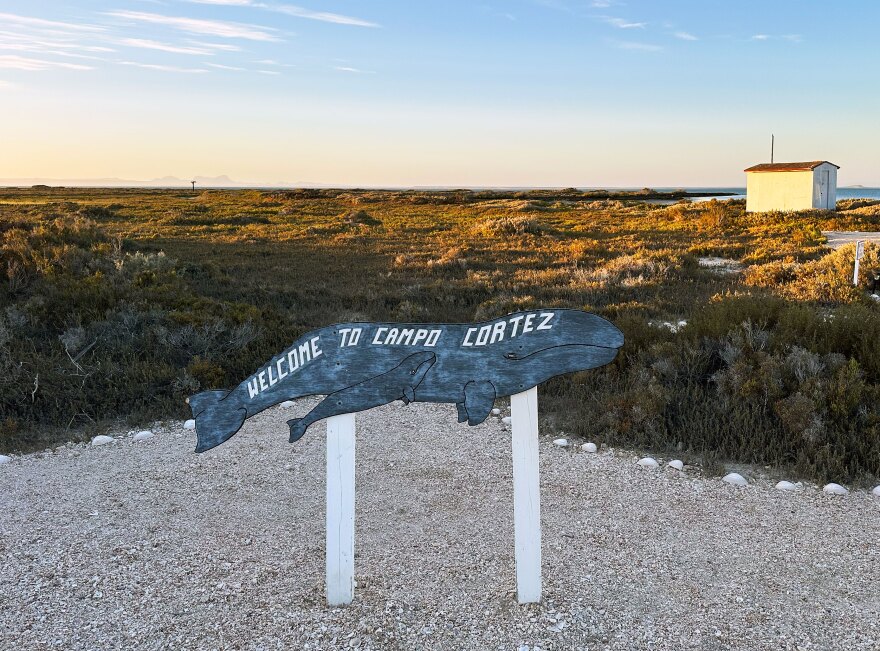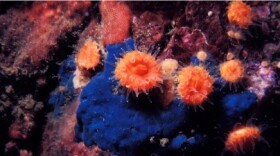Gray whales pass through Washington waters every year as they complete a 10,000 mile migration along the West Coast. They’re also the target species for a possible renewed hunt by the Makah Tribe. And there’s an annual trip many Whidbey Island whale watchers make, a kind of pilgrimage, to San Ignacio Lagoon, in Baja California.
That’s where gray whales mate and give birth every winter. And they’re known to be amazingly friendly to tourists, especially the mother whales, who spend several months in the warm shallow waters, nursing and rearing their calves.
This unique interaction is something I wanted to see. This year, I decided to go along.
To get to San Ignacio, we piled into a pair of tiny, chartered jets for a three-hour flight from Tijuana and landed at an oasis of an airport in the desert.
A couple of vans picked up our group for the ride to camp. As we bumped along on the rough road to the lagoon, with nothing but wide-open, arid landscapes all around us, fellow-traveler Dawn Glavick asked our guide a question that had been looming large for many in the group.
“We've been told by a couple people that there's not as many whales. Please put everyone's mind at ease,” she said.
Back home, Glavick works as a marine naturalist and kayak tour guide on Whidbey Island. She went on this trip last year and said it was amazing, with multiple close encounters with the gray whales.
“I don't remember the statistics, but I know that no matter where we seemed to look, there was a blow or a breach or a spy-hop or a baby,” Glavick said.
Concern for state of the whales
Recent years have been hard on gray whales and the scene in the lagoons has reflected that.
“We've had a lot of behaviors, you can still see all of that, but the numbers, the total numbers, are much reduced,” said MT Solomons, one of our three guides for the trip, as she navigated the bumpy road to camp.

The recent die-off of gray whales is officially over. But the effects of the so-called "Unusual Mortality Event" are still being felt. Nearly half of the gray whale population died in four years. It’s unclear what that will mean for the whale population long term. They’re expected to rebound, but…
“It means that perhaps there are less mothers and babies going north, or the condition of the mothers isn't strong enough to produce another pregnancy in a couple of years following,” Solomons said.
“And on top of that, we've got this year a La Niña.”
The La Niña’s cooler temperatures appear to have caused many of the whales to skip the lagoons and migrate farther south, in search of warmer water.
So, even though there are still lots of gray whales in San Ignacio Lagoon, the most recent weekly count for the official census ahead of our tour was down by more than half of normal: only 76 compared to the usual count of more than 200.
Campo Cortez – heart of San Ignacio whale watching
We saw those numbers every day, hand written on a whiteboard inside the large new palapa at the heart of our camp. Campo Cortez is located on the edge of San Ignacio Lagoon, in a UNESCO World Heritage site that’s part of Mexico’s largest wildlife preserve. Everything here aims to honor the whales and their wellbeing.

Upon arrival, we learn that all our water will be hauled in and out, to keep the lagoon pristine. We’ll sleep in small plywood cabins that resemble tiny homes, and share our camp with several huge osprey nests.
Outside the kitchen, overlooking the lagoon, I sit down with Maldo Fischer. He’s the head of the camp, which his entire family helps run. He said he started taking tourists out to whale watch more than 35 years ago.
He was scared at first. His boat was only 18 feet long — less than half as long as a typical gray whale.
“[It was a ] very small boat. The gray whale is 35 foot. You know?!’ he exclaimed.
There was one whale they called “La Loca,” who taught him just how friendly these whales could be. The whale came up and seemed to be hugging the boat from below, he said.
Fischer founded and now leads a whale watch association for San Ignacio, to make and enforce voluntary rules.

There are limits on boat numbers and how much time is spent with the whales — which is only allowed in a designated area, and enforced by a sheriff and park rangers. And, Fischer said, given the current state of the whales, there might be more restrictions coming.
As we motored out for our first whale watching excursion, all eyes were on the water. Everyone — the tourists, guide and driver — scanned for blows and other signs.
We saw a pair of bottlenose dolphins, swimming and porpoising alongside us, signaling our first sighting of a whale, diving nearby.
Eventually, the captain cut the motor and let the boat drift. We got within a few yards of some whales, close enough that we could see barnacles on their skin and almost feel the enormous exhaling that happens before a dive.
As the day wore on, we saw lots of whales. Some seemed curious, spy-hopping straight into the air to see us. Some of us even sang and splashed the water in hopes of luring them closer. But we didn’t get to touch them — or have any close encounters with mothers and their babies.
A meditation on giving space
That evening in camp, Solomons, our guide, offered a meditation circle with singing bowls to help us adjust our expectations about touching whales.
“Come back to your heart center. Bring the mind to the heart. Connect to your heart,” she said.
With fewer whales around, she encouraged us to stop grasping for encounters and instead focus on giving and receiving and bring that energy to the boats.
Then she asked us if anyone wanted to share their intentions. I found myself speaking up. I liked the invitation to give the whales more space. I was feeling concerned that it wasn’t really something we should do.
“So I think it's just fine not to touch them,” I said. “To not have encounters where we touch them.”
And the next day, once again, we didn’t.

The third day was our last chance.
I woke up early and wandered over to the water’s edge. I sat down outside the palapa with my recording gear and did a bit of oral journaling, speaking my thoughts into my microphone.
“It does seem like things are at a bit of a turning point here, in terms of the reputation and marketing for really close encounters with the whales,” I noted.
After my conversation with Fischer, the camp operator, I wondered if they could continue to encourage people to expect to touch and even kiss the whales or put their hands in the whales’ mouths. All of this had been part of the picture in the past, in a very a joyful and friendly way that the whales didn't seem to object to.
Now, Fischer had told me, they were considering taking a break. But it was still all very uncertain.
A close encounter after all
Later that morning, we motored out into the lagoon on flat water with lots of birds all around — pelicans, cormorants, gulls and terns.
In less than a quarter of an hour, we found ourselves in the presence of a very friendly pair of whales. Our guide, Natalia Figueroa, encouraged us to sing and splash to get their attention. It worked.
“Like, do it for real!” she urged, as she also splashed the water vigorously.
It’s hard to fully describe the interactions that followed. The whales swam as close as they possibly could to our boat , rubbing against it and diving beneath. The calf opened its mouth, looking for touches and clearly eager to interact with us. Excitement and adoration, oohing and aahing filled the boat and overflowed.

This went on for more than a half an hour. “I touched the whale, I did it!” one passenger exclaimed loudly — the goal of her long travels fulfilled.
I also — gently, hesitantly — touched the top of the baby’s head, once. Others repeatedly rubbed both whales’ skin and splashed them. Some people cried because of the communion. And I … couldn't stop laughing.
Reflections
Back at camp that night, I asked my new friend Dawn Glavick, the marine naturalist from Whidbey Island, for her take on all this. The boat she was on that day didn’t have the same kind of close and intense encounter we did — no touches. But she did get a good look at a calf.
“That little baby came up and our eyes met, and that was all I was looking for. You look into the eye of a whale and it changes your life forever. You carry it,” she said.
I didn’t get to look a whale in the eye. But that whale watch day was so moving — the surprising joy I felt during the interactions on our boat will certainly stay with me.

After I returned from San Ignacio Lagoon, reports came out that as many as 70 gray whales have died since the start of the year in the lagoons of Baja California. Scientists are concerned but not sure what is causing it.
NOAA Fisheries hasn’t issued any conclusions and said the number of strandings off the Pacific coast of the U.S. is still low. The whales are just now at the beginning of their migration north.







